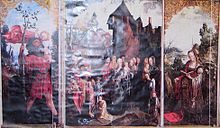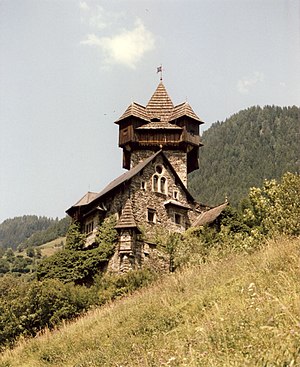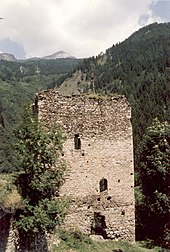Falkenstein Castle (Obervellach)
| Falkenstein Castle | ||
|---|---|---|
|
Niederfalkenstein Castle |
||
| Alternative name (s): | Valchenstain, Walchenstein; Oberfalkenstein, Unterfalkenstein (Niederfalkenstein) |
|
| Creation time : | 1164 | |
| Castle type : | Hilltop castle | |
| Conservation status: | Ruin (Oberfalkenstein) ; Preserved or essential parts preserved (Niederfalkenstein) |
|
| Standing position : | Ministeriale | |
| Place: | Obervellach- Pfaffenberg | |
| Geographical location | 46 ° 55 '20.4 " N , 13 ° 14' 24.6" E | |
|
|
||

The Falkenstein Castle is a fortification in Obervellach in Carinthia , the two spatially separated main building also Oberfalkenstein and low Falkenstein be mentioned.
location
In the village of Pfaffenberg to the east of Obervellach, Falkenstein Castle stands on a rocky ridge that grows from the steep northern flank of the Mölltal valley, high above the Mölltalstrasse (B 106).
The rock, which the Tauern Railway undergoes through a 67 m long tunnel, carries the ruins of Oberfalkenstein. What is referred to as Unterfalkenstein or Niederfalkenstein Castle in our time was not a castle in the past , but only an outbuilding of the Oberfalkenstein Castle , which is significantly higher up.
The two castles in the eastern region of the Hohe Tauern are approx. 25 minutes' walk from each other.
investment
Falkenstein Castle was secured from falling by arched pillars and buttresses and was surrounded by a defensive wall that was repaired and secured during the construction of the Tauern Railway so that it could withstand the blasts in the tunnel more easily.
Oberfalkenstein Castle
The old Oberfalkenstein Castle was a Romanesque type with a square, four-story keep at the entrance to the castle on the mountain side, with a moat in front of it. The Palas , only recognizable in its basic square, consisted of very strong walls. There was also a small Romanesque chapel here, in which at times even a chaplain performed the services.
chapel
In 1295 a Haenicus and in 1346 an Engelbrecht are mentioned as "Capellanus on upper valchenstain". The chapel consecrated to St. John was expanded into a church by the Pfaffenberg farmers in 1772 and is still in use. The Romanesque wall core can still be seen on the church. It is a hall without an apse , but has a two-storey wooden gallery. The high altar and a ceiling painting show the baptism of Christ. Full-length images of the Gospels can be seen in the pulpit. While the side altar of Mary and the other sacred works of art date from the 18th century, the castle church still has a panel painting of St. Barbara, the patron saint of miners, made in the 16th century.
history
It is no longer possible to determine with certainty when Falkenstein Castle was built. In any case, it is one of the oldest castle buildings in the province of Carinthia and was first mentioned in a document in 1164. At that time it was called Valchenstain , later also Walchenstein . This name spelling suggests that it could be a Walchen settlement. The Walchen are the "Wallischen", as the Italians are also called in the alpine dialect. In fact, a place called "Walaha", ie a Welsch settlement, was documented in the vicinity of Falkenstein Castle. Presumably, these settlers are the remains of the former inhabitants of the Roman Teurnia . The last Romans of the Noricum evaded the advance of the Slavs just before 600 AD by retreating into the neighboring mountains.
The lords of Falkenstein were ministerials , that is, aristocratic followers of the Meinhardin Counts of Gorizia . A Gumpoldus de Valchenstein can be identified as the third of this family in 1164, who was expressly designated as the ministerial of Count Engelbert I of Pusteria . It was not until 1200 that these aristocrats called themselves Counts of Gorizia .
In 1271 Otto von Falkenstein ruled in a dispute between the Counts of Görz and the Admont Abbey , which was wealthy in the upper Mölltal, about Neubrüche in the area of Stall in the Mölltal.


The Falkensteiners cultivated friendly relations with the Benedictine monastery Millstatt . In 1272 a daughter of Chotos von Falkenstein entered the Millstatt convent. This existed since the 12th century next to the male monastery there. As a dowry, the Falkensteiner bequeathed a hat in Litzelsdorf to his daughter and the Millstatt monastery.
Soon after 1300 the family von Falkenstein seems to have died out, because in the following years the Counts of Gorizia made a distinction between an upper and a lower “Valchensteyn”, which they awarded separately to smaller nobles . On June 24, 1394, Count Heinrich IV of Gorizia pledged the Upper Falkenstein to the Austrian Duke Albrecht III. Because Count Heinrich was later no longer able to redeem the pledged castle, it remained under the rule of the Habsburgs , who now treated Falkenstein as their property. With the Peace of Pusarnitz , the Falkenstein rule came into the possession of the Habsburgs. Emperor Friedrich III. left both castles to different keepers, who changed quickly and constantly had to pay high sums of money. Until 1462, Andreas von Graben zu Sommeregg was also named as the lord of the castle Unterfalkenstein .
In 1504, Maximilian I pledged , who in 1493 gave his father Friedrich III. as regent followed, the castle and the regional court Falkenstein as well as the offices of Vellach (Obervellach) and Kirchheim (Großkirchheim) in the upper Mölltal to Julian, Count of Lodron , because he had lent the court chamber 7,500 guilders. Apollonia, the wife of the Count, née Lang von Wellenburg and sister of the Salzburg Archbishop Cardinal Matthäus Lang von Wellenburg , lost her husband as early as 1510. She was married to Christoph Graf von Frangipani , a Croatian nobleman who served as Imperial Commander-in-Chief in 1514 had lost his freedom in Friuli . Mrs. Apollonia Frangipani donated a famous altarpiece by the Dutch painter Jan van Scorel for Obervellach .
In those years, Falkenstein Castle was in a bad state of construction, so in 1507 the later emperor allowed Count Lodron to build 500 guilders. Around 1510, the widowed countess was allowed to use another 200 guilders to rebuild the dilapidated castle.
After Frangipani's childless marriage, the Falkenstein rulership changed owners several times, including, for a short time, the rich gold works Christoph Weitmoser , Count Ferdinand von Salamanca-Ortenburg and Bartholomäus Khevenhüller .
From 1693 to 1883 the castle was owned by the Barons von Sternbach, who let the fortress fall into disrepair because they had their residence in Groppenstein Castle, west of Obervellach. In August 1825, the Viennese alpinist and court chamber official Josef Kyselak (1798–1831) visited the Falkenstein ruins on his Austria hike. He finds a large tower with a well-designed beehive in it, the first that I saw in Carinthia, and a little church with a wooden tower. More than the ruins, he is fascinated by the mountain farming landscape all around: individual huts leaning against rocks 1000 fathoms high, begging the huge rulers for protection; Strips of meadows that rise sparingly every now and then sell a handful of grass for danger to life ... In 1905 Falkenstein Castle acquired Hofrat Ferdinand Kaltenegger von Riedhorst, who gave Unterfalkenstein Castle its present appearance.
After his death in 1912 the owner of the renovated castle changed, which from 1939 to 1947 was owned by Georg Friedrich Scheier, adopted Baron Trütschler von Falkenstein. Baron Trütschler's son sold the two castles in 1959 to Anni Helene Johanna Oehmichen, a Dithmarsch import and export clerk who had previously lived in China, Japan and the USA. Since Niederfalkenstein Castle was already very dilapidated in 1959, Ms. Oehmichen again invested a considerable fortune in the restoration. She also furnished the castle with valuable paintings and antiques.
Ms. Oehmichen's efforts were followed by an arson attack by a burglar, during which the Palas (the main building of the castle) and its valuable inventory burned down to the foundations in 1969. The burglar, who allegedly wanted to cover his tracks with the arson, was caught immediately after the crime with a backpack full of silver in the Mallnitz-Böckstein railway tunnel.
Ms. Oehmichen deserves the credit - after this hard blow of fate - to have rebuilt and furnished the hall of Niederfalkenstein Castle (memorial plaque, to the right of the main gate of the castle, donated by the municipality of Obervellach). Ms. Oehmichen died in 1987 at Niederfalkenstein Castle after a long, serious illness.
After the death of Ms. Oehmichen, ownership of the Oberfalkenstein castle ruins and Niederfalkenstein castle passed to her two nephews Rolf-Peter Oehmichen (Hamburg, Germany) and Erhard Christian Mahnke (Burlington, Vermont, USA) through inheritance. Rolf-Peter Oehmichen again carried out extensive renovations on the castle complex, including a new covering of the roofs of the tower and the battlements with hand-pounded larch shingles, some of which were up to one meter long. In 1989 the two nephews sold the Oberfalkenstein ruin to Mr Weißmann. In 1998 Niederfalkenstein Castle was sold to the Fersterer family, a family of hoteliers from Saalbach.
Falkenstein Castle (Niederfalkenstein) has been open to visitors in the summer months since 2016.
Others
On November 13, 1973, the Austrian Post issued a definitive stamp of the series Landscapes from Austria for this motif for 7.00 Schilling.
There is a 1:87 (H0) scale model of the Niederfalkenstein Castle by Kibri .
See also
literature
- Gerhard Stenzel: From castle to castle in Austria . Kremayr & Scheriau, Vienna 1973, ISBN 3-218-00229-X .
- Georg Clam Martinic: Austrian Castle Lexicon. Castles and ruins, mansions, palaces and palaces . 2nd Edition. Landesverlag, Linz 1992, ISBN 3-85214-559-7 .
- Michael Leischner, Alois Brandstetter: Castles and palaces in Carinthia . Carinthia, Klagenfurt 2000, ISBN 3-85378-520-4 .
- Hermann Wiessner, Gerhard Seebach: Castles and palaces in Carinthia. Wolfsberg, Friesach, St. Veit . Birken, Vienna 1977.
Web links
- Official website Burg Falkenstein
- Entry via Oberfalkenstein to Burgen-Austria
- Entry via Unterfalkenstein (Niederfalkenstein) to Burgen-Austria
Individual evidence
- ↑ Falkenstein ruins In: Goffriller, Gabriele (ed.): Kyselak. Sketches of a foot trip through Austria. Salzburg, 2009. pp. 131-132.
- ↑ Deborah Schumann: A look behind the gate. Accessed June 12, 2019 (German).




